
There are four basic types of drumsticks, and we’ll go over each one in this guide:
And there are five basic types of drumstick tip shapes:
Out of all the drumsticks on the market, which ones are the best for you?
This guide will give you a detailed rundown of the most common drumstick types and what to look for the next time you’re hunting for a pair.
Here’s a quick overview of the different types of drumsticks:
Get access to the beginner video course that’ll have you confidently playing along with your favorite songs in just 90 days: New Drummers Start Here.
Drumsticks have been around for a long time. For drum kit players, these are your ultimate tools. The feeling of these in our hands is what makes most drummers fall in love with drumming from day one.
When you’re a new drummer, it can be tricky to choose which drumstick types to get. You might notice that every stick has a set of letters and numbers.
In a nutshell:
Lower number = thicker stick
Higher number = thinner stick
The most common numbers you’ll see are 2, 5, 7, and 8. The lower the number, the thicker/heftier the stick and the larger the circumference.
‘A’ refers to a lighter stick, while ‘B’ means the stick is a bit heavier. All other sticks with varying letters fall somewhere in between these two.
These are the most common drumstick sizes you’ll see at music retailers:
Most drumsticks used on the drum set are around 16″ long but can range from 15-17.5″. You can sometimes find extra-long sticks (like the Vic Firth ‘Extreme’ line or the Los Cabos ‘Intense’ line) if you’re looking for a different feel and response.
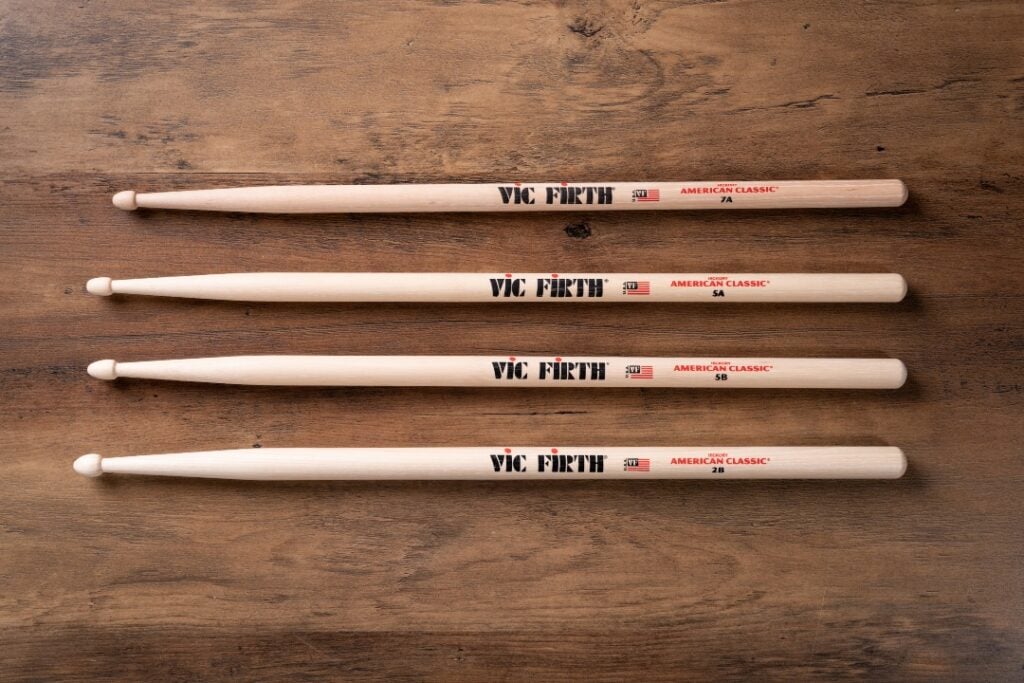
Most drumsticks are made from a select group of woods and other materials:
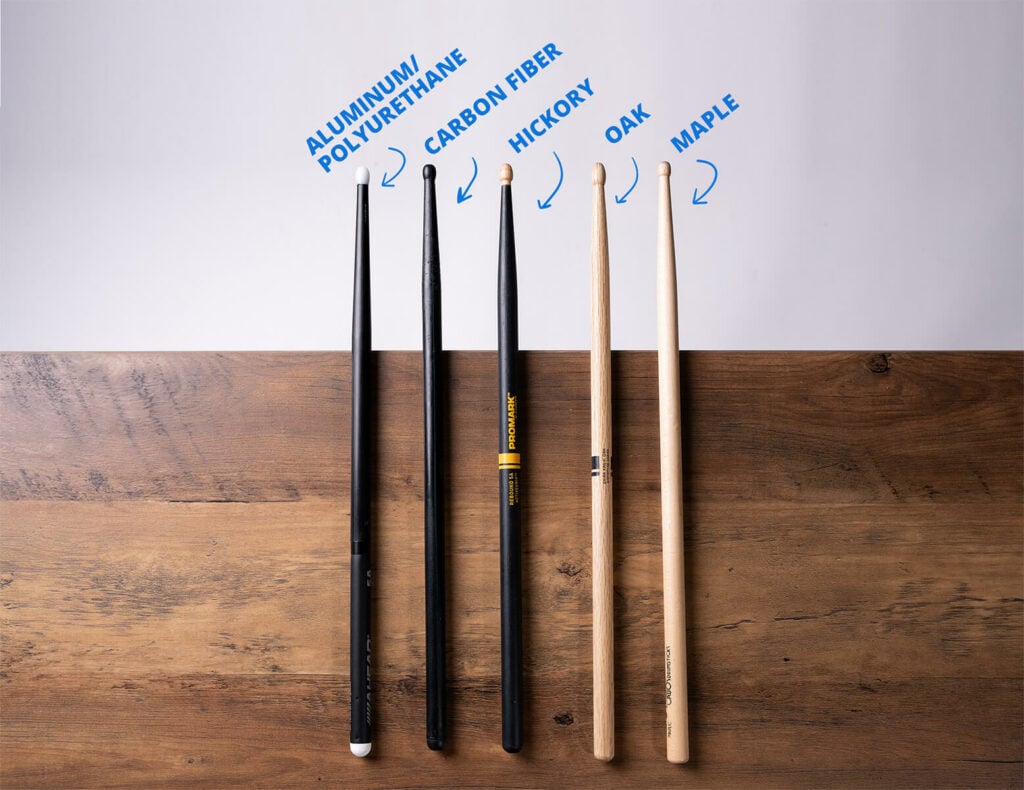
Maple is a good lightweight wood while aluminum is a lightweight metal option. Hickory and maple are the most common drumstick materials.
The type of wood largely determines the weight of the sticks and how they sound. Another factor is the type/shape of their tips:
…which can slightly alter how the sticks feel when you strike the drumheads.
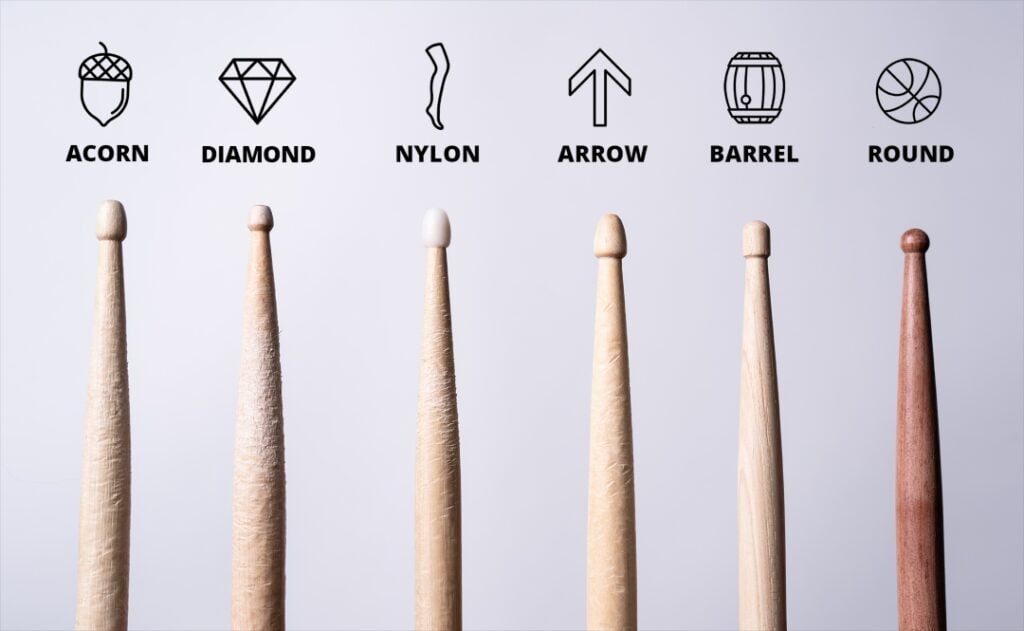
All of these tips are made from wood except nylon, which changes how the sticks sound when they hit the cymbals. Nylon-tipped sticks can give you a more consistent tone from one pair to another.
A big debate among drummers is whether to get sticks with nylon or wooden tips. Nylon tips sound bright, while wooden tips sound warmer and more natural.
If you don’t know which tips you want on your sticks, test a few and let your ears decide.
At the end of the day, the best types of drumsticks are the ones that aren’t broken. Don’t get too stuck on which specific sticks to choose, as they all have the same purpose.
It comes down to personal preference, but here’s some help from Jared Falk on narrowing down your choices:
Brushes are made from a thin set of evenly spread out wires. The volume you get from the drums is a lot quieter when using brushes, so they’re often used for soft settings. This is one of the main reasons drummers will choose brushes over drumsticks.
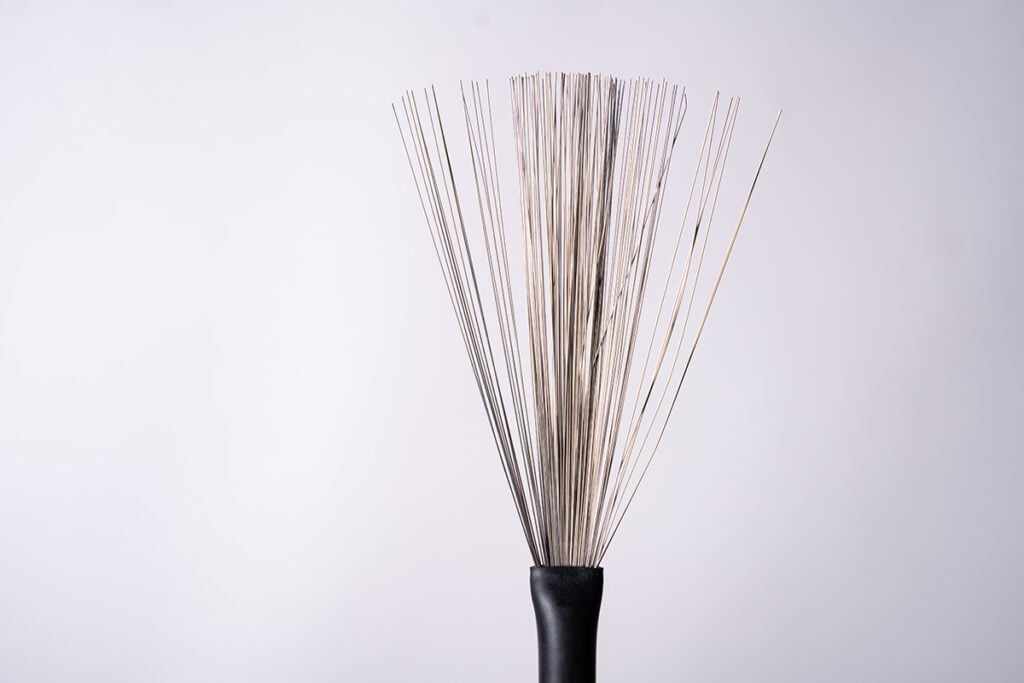
You can play like you would with standard sticks to get a mellower impact from the drums and cymbals. You can also sweep them over the snare drum head to get a swishing sound, which is an iconic brush playing technique.
Brushes are mostly used in jazz drumming, but there’s also a place for them in other modern music. There’s a bit of a learning curve to master brushes, but it opens up a whole new world of options.
Even if you never end up using them, brushes are valuable tools to have in your stick bag, and learning to use them will only expand your drumming skillset.
Check this video of Jason Sutter giving the rundown on how to play with brushes:
Rods (also known as ‘rute sticks’) are another quiet alternative to standard drumsticks. Comprised of a bundle of thin sticks that’ve been strapped together, you may have been asked to use these if you’ve performed in a small venue or church.
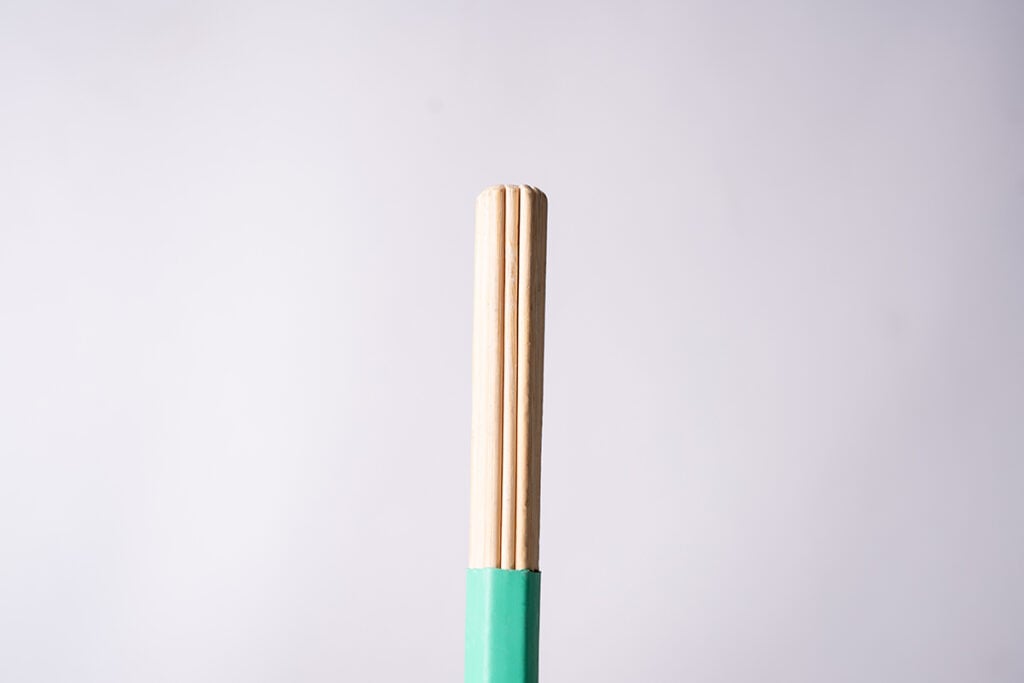
The striking sound you get from rods is less intense than standard drumsticks, but you get more attack and volume than you do from brushes.
Some rods are made from wood while others are plastic or synthetic fiber. Thanks to their heavier weight, wooden rods tend to sound a bit louder. Plastic rods are quieter, and they don’t break as easily as wooden rods.
Rods are the perfect tools to use in places like coffee shops. You can play everything on the kit without overpowering the environment with sound. However, you lose a bit of stick definition on the cymbals compared to a standard drumstick.
Mallets are sticks that have thick material pieces at the end. This material completely changes how the sticks sound when they strike drums and cymbals.
The thicker the material at the end of a mallet, the warmer the sound will be. Almost all attack goes out the window, so they’re perfect for cymbal swells and tom rolls and builds.
You’ll see many drummers playing drum solos with mallets as their unique sound adds variety to the soundscape.
Mallets take away the sharp cracking sound that cymbals produce, and that’s why they work so well for swells. As you repeatedly hit a cymbal with mallets, the warm sound resonates and gets louder. It’s the classic song starter and finisher.
If you don’t have a set of mallets yet, you could always DIY it by attaching cymbal felts to the ends of your sticks.
Every now and then, a drumstick brand will create something unique that combines different stick types and materials: a hybrid stick.
The most common type of hybrid stick has a standard drumstick tip on one end and a mallet tip on the other end. These are amazing for drummers who don’t want to risk dropping their sticks while switching between mallets and standard sticks mid-song. Just flip these around whenever you want to play warmer tones or cymbal swells.
Musical theater drummers tend to be the biggest lovers of hybrid mallets, but it won’t hurt anyone to have a pair of these handy.
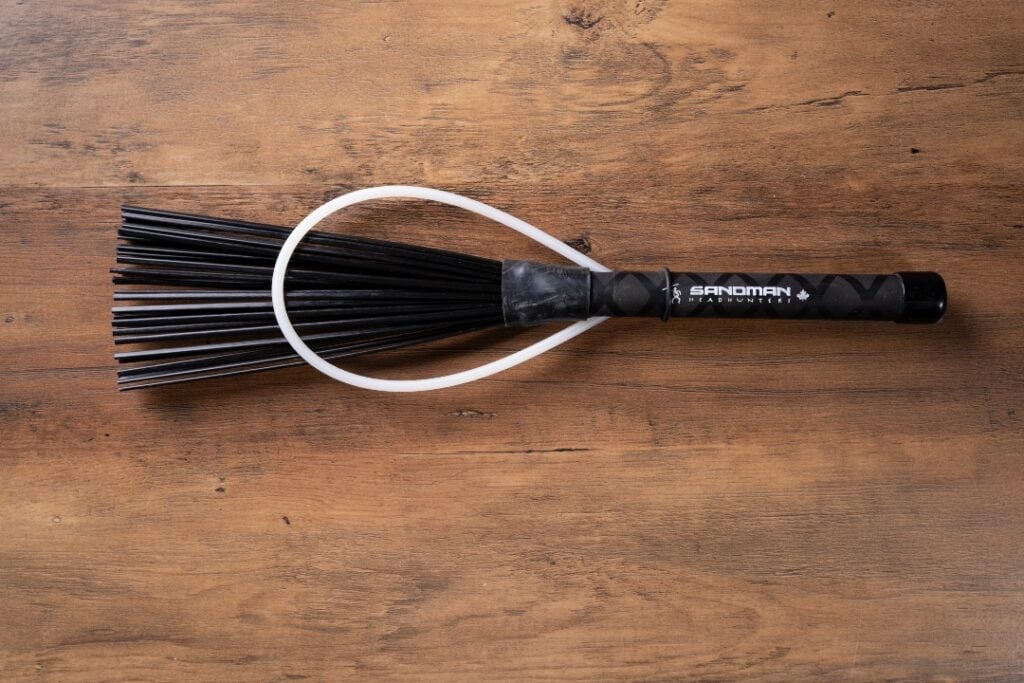
You may also come across sticks with wire bristles or another material at the end to add a bit of flavor to the sticks. Some hybrid sticks are a lot more practical than others, so keep that in mind before choosing the latest Frankensticks to be your trusted pair.
Signature drumsticks get a section on their own because they’re often different from standard stick designs. These are made when artists get involved with a brand’s design process and the stick specs are made to fit the artist’s tastes.
When using a pair of signature drumsticks, you’re playing what a particular drummer thought would be the perfect stick.
Many signature sticks have unique additions that aren’t commonly found on standard drumsticks. For example, check this clip that features Gavin Harrison’s signature drumsticks with a matte dipped grip:
It’s useful to have every type of drumstick in your stick bag, but you may use some more than others. Focus on standard drumsticks first since you’ll likely use them the most.
The other types of sticks you should get will depend on what styles of music you play. You’ll need brushes for jazz and mallets for musical theater. Look around to see what’s out there, try a few different pairs, and your stick bag will turn into your trusted arsenal of tools in no time.
Drumeo Team - We're professional, award-winning drummers and drum teachers, coaches, recording artists, and content specialists who are passionate about drums and helping drummers around the world. This post was written and/or edited by Sam Landa, Brandon Toews, Jared Falk, Dave Atkinson, or another pro on our team (which has a combined 1000+ years of drumming experience). Are you looking for inspiration, education, and support to take your playing to the next level? Join the Drumeo community today!


By signing up you’ll also receive our ongoing free lessons and special offers. Don’t worry, we value your privacy and you can unsubscribe at any time.
We use cookies for traffic data and advertising. Cookie Policy »